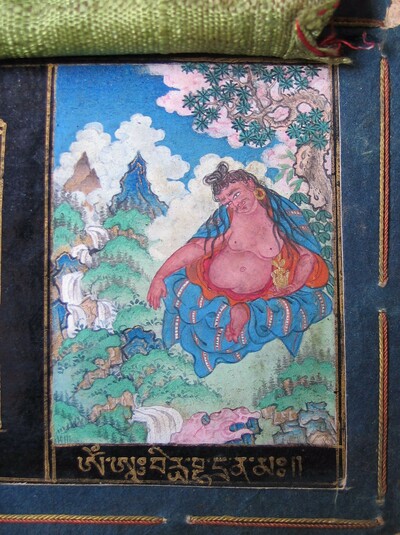
Item: Teacher (Lama) - Tangtong Gyalpo
| Origin Location | Tibet |
|---|---|
| Date Range | 1600 - 1699 |
| Lineages | Jonang (Sakya), Shangpa Kagyu and Buddhist |
| Material | Ground Mineral Pigment on Paper |
| Collection | Rubin Museum of Art |
Viryabhadra, otherwise known as Tangtong Gyalpo. This is one of twelve illuminations from the manuscript text, volume two, of Gyurme Dechen. (See Tangtong Gyalpo Main Page and Outline Page).
Tangtong Gyalpo Tsondru Zangpo (1385/61-1464/85) typically appears as an old man with long white hair, a long white beard, and depicted in a seated posture. Sometimes he is shown with a very dark complexion - dark brown. There are no typical hand attributes for Tangtong Gyalpo, but, he sometimes holds a medicinal pill in the upraised right hand, or a link of chain in the right hand - extended across the knee. The left hand can hold a skullcup in the lap, a long-life vase, or a combination of the two. He is generally depicted in a very relaxed seated posture, the feet bare. (See the Men With Beards Outline Page).
The dates of Tangtong Gyalpo are not precisely known because of the different sources of the time not being in agreement (1385/61-1464/85). He can however be easily placed in the 14th/15th century because of the historical accounts of people that he met and the accounts of people who met him.
Tangtong Gyalpo was famous for building iron bridges throughout Tibet as well as creating many new medicinal formulas for both healing and longevity. Many of these formulas are still used today. Tangtong Gyalpo is credited with the invention of Tibetan opera (theatre) known as Achi Lhamo. It is thought by some that he developed opera as a way of funding his various bridge building projects. Others dismiss the idea entirely and find no relationship between Tangtong Gyalpo and Achi Lhamo.
Tangtong Gyalpo was very closely related to both the Sakya and Shangpa Kagyu Tarditions. He is even aknowledged as the founder or patriarch of a specific line of Shangpa known as the Chagzam Lineage. Most of the written works of Tangtong Gyalpo, of which there are not many, are meditational practices of various sorts that he developed based on 'Pure Vision' experiences gained at particular locations throughout Tibet. The other written materials are works related to Shangpa Kagyu meditation practices. Within the Nyingma Tradition of Tibetan Buddhism there is a vast corpus of literature alleged to be from the hand of Tangtong Gyalpo dealing with the many 'Revealed Treasure' teachings he uncovered during his lifetime and many travels throughout Tibet.
Jeff Watt 4-2011
Manuscript: Gyurme Dechen Illuminations
Teacher: Tangtong Gyalpo (Masterworks)
Teacher: Tangtong Gyalpo Main Page

